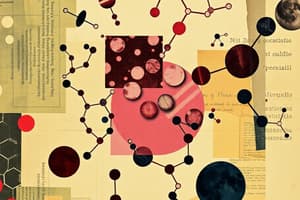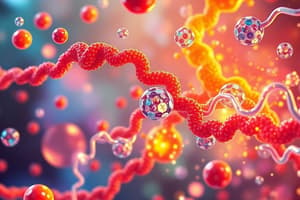Podcast
Questions and Answers
Where is a centre of asymmetry in triacylglycerols?
Where is a centre of asymmetry in triacylglycerols?
- Carbon-4 of the glycerol backbone
- Carbon-3 of the glycerol backbone
- Carbon-1 of the glycerol backbone
- Carbon-2 of the glycerol backbone (correct)
Which of the following is NOT a source of triacylglycerols?
Which of the following is NOT a source of triacylglycerols?
- Storage depots in adipocytes
- Digestion of dietary carbohydrates (correct)
- De novo synthesis in liver
- Nomenclature of simple triacylglycerides
What is the difference between oils and fats?
What is the difference between oils and fats?
- Oils are derived from plants while fats are derived from animals
- Oils are liquid at room temperature while fats are solid (correct)
- Oils are solid at room temperature while fats are liquid
- Oils contain saturated fatty acids while fats contain unsaturated fatty acids
Why do triacylglycerols release more energy when degraded compared to carbohydrates?
Why do triacylglycerols release more energy when degraded compared to carbohydrates?
What is a characteristic of triacylglycerols that helps prevent heat loss?
What is a characteristic of triacylglycerols that helps prevent heat loss?
What is the major function of triacylglycerols in the body?
What is the major function of triacylglycerols in the body?
What is the composition of monoterpenes?
What is the composition of monoterpenes?
Which compound is a monoterpene found in the oil of geranium?
Which compound is a monoterpene found in the oil of geranium?
What is the defining characteristic of steroids in terms of structure?
What is the defining characteristic of steroids in terms of structure?
Which compound is a carotenoid, known for its orange-colored pigment?
Which compound is a carotenoid, known for its orange-colored pigment?
What is the main role of eicosanoids?
What is the main role of eicosanoids?
Which compound is classified under isoprenoids and is a key component in Lipid vitamins?
Which compound is classified under isoprenoids and is a key component in Lipid vitamins?
Which type of molecules are lipids?
Which type of molecules are lipids?
Which fatty acid is abundant and is commonly an important component of lipid molecules?
Which fatty acid is abundant and is commonly an important component of lipid molecules?
What type of interactions are involved in the association of lipid molecules?
What type of interactions are involved in the association of lipid molecules?
What makes fatty acids important metabolic fuels?
What makes fatty acids important metabolic fuels?
Which types of fatty acids contain zero to three double bonds?
Which types of fatty acids contain zero to three double bonds?
What is the range of saturated fatty acids that have been found in nature?
What is the range of saturated fatty acids that have been found in nature?
What is the main role of cholesterol in plasma membranes?
What is the main role of cholesterol in plasma membranes?
Which class of hormones does cholesterol serve as a precursor for?
Which class of hormones does cholesterol serve as a precursor for?
Which plant-derived compound is a time-honored stimulator of cardiac muscle contraction?
Which plant-derived compound is a time-honored stimulator of cardiac muscle contraction?
What structural feature is common among all major human plasma lipoprotein classes?
What structural feature is common among all major human plasma lipoprotein classes?
What is the main function of plasma lipoproteins in mammals?
What is the main function of plasma lipoproteins in mammals?
What is the systematic name of the fatty acid with the numerical symbol 18:3(9,12,15)?
What is the systematic name of the fatty acid with the numerical symbol 18:3(9,12,15)?
Which lipid-soluble antioxidant molecules are found in plasma lipoproteins?
Which lipid-soluble antioxidant molecules are found in plasma lipoproteins?
Which fatty acid is the biosynthetic precursor of prostaglandins?
Which fatty acid is the biosynthetic precursor of prostaglandins?
What is the trivial name for the compound with the systematic name cis-9-Hexadecenoic?
What is the trivial name for the compound with the systematic name cis-9-Hexadecenoic?
In what biological fluid do prostaglandins act on smooth muscles?
In what biological fluid do prostaglandins act on smooth muscles?
Which fatty acid is primarily found in the lipids of the nervous system?
Which fatty acid is primarily found in the lipids of the nervous system?
What is the numerical symbol for the fatty acid named Hexadecanoic with the trivial name Palmitic?
What is the numerical symbol for the fatty acid named Hexadecanoic with the trivial name Palmitic?
Flashcards are hidden until you start studying
Study Notes
Lipids
- Lipids are a group of naturally occurring compounds that are readily soluble in organic solvents such as hydrocarbons, chloroform, benzene, ethers, and alcohols.
- They are water-insoluble organic molecules that are not polymers.
- Lipids have a strong tendency to associate through noncovalent forces, including ionic bonds, hydrogen bonds, van der Waals forces, and hydrophobic interactions.
Classification of Lipids
- Simple lipids: fatty acids, waxes, and triacylglycerols
- Complex lipids: phospholipids, sphingolipids, isoprenoids, and lipoproteins
Fatty Acids
- Fatty acids are monocarboxylic acids that contain hydrocarbon chains of variable lengths.
- They are important components of several types of lipid molecules.
- Fatty acids are important metabolic fuels, with the oxidation of fatty acids yielding more energy (37 kJ/g) than the oxidation of proteins or carbohydrates (16 kJ/g).
- Common saturated fatty acids include:
- C16: palmitic acid (hexadecanoic acid)
- C18: stearic acid (octadecanoic acid)
- Common unsaturated fatty acids include:
- C16:1: palmitoleic acid (cis-9-hexadecenoic acid)
- C18:1: oleic acid (cis-9-octadecenoic acid)
- C18:2: linoleic acid (cis,cis-9,12-octadecadienoic acid)
- C18:3: linolenic acid (cis,cis,cis-9,12,15-octadecatrienoic acid)
- C20:4: arachidonic acid (cis,cis,cis,cis-5,8,11,14-eicosatetraenoic acid)
Triacylglycerols
- Triacylglycerols are composed of a glycerol moiety with each hydroxyl group esterified to a fatty acid.
- They are the major storage and transport form of fatty acids.
- Examples of triacylglycerols include:
- Tristearin (contains 3 residues of stearic acid)
- Tripalmitin (contains 3 residues of palmitic acid)
- Triolein (contains 3 residues of oleic acid)
Phospholipids
- Phospholipids are complex lipids that contain a phosphate group and are amphipathic, meaning they have both hydrophobic and hydrophilic regions.
- Examples of phospholipids include:
- Phosphatidic acid
- Sphingomyelin
Steroids
- Steroids are complex derivatives of triterpenes that are composed of four fused rings.
- They are distinguished from each other by the placement of carbon-carbon double bonds and various substituents.
- Examples of steroids include:
- Cholesterol
- Steroid hormones (e.g. glucocorticoids, mineralocorticoids, androgens, estrogens, progestins)
Lipoproteins
- Lipoproteins are any protein that is covalently linked to lipid groups.
- They are found in blood plasma and transport lipid molecules through the bloodstream from one organ to another.
- Examples of lipoproteins include:
- Chylomicron
- VLDL (very low-density lipoprotein)
- IDL (intermediate-density lipoprotein)
- LDL (low-density lipoprotein)
- HDL (high-density lipoprotein)
Eicosanoids
- Eicosanoids are unsaturated fatty acids of 20 carbon atoms that contain 5-membered rings.
- They are precursors of prostaglandins and other eicosanoids.
- Examples of eicosanoids include:
- Arachidonic acid (20:4(n-6))
- Prostaglandins (e.g. PGA, PGB, PGD, PGE, PGF)
Terpenes
- Terpenes are a class of lipids that are composed of isoprene units.
- They are found in essential oils of plants and are classified based on the number of isoprene units they contain.
- Examples of terpenes include:
- Monoterpenes (e.g. geraniol)
- Sesquiterpenes (e.g. farnesene)
- Diterpenes (e.g. phytol)
- Triterpenes (e.g. squalene)
- Tetraterpenes (e.g. carotenoids)
- Mixed terpenoids (e.g. vitamin E, ubiquinone, vitamin K)
Studying That Suits You
Use AI to generate personalized quizzes and flashcards to suit your learning preferences.




